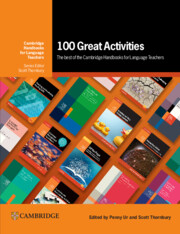3 - Reading
Published online by Cambridge University Press: 14 March 2024
Summary
Typically, coursebooks expect learners to respond to written texts by answering a series of comprehension questions. Depending on how these questions are framed, they may not in fact test comprehension at all, but instead test common sense, general knowledge or simply word recognition. All of the activities in this section, however, invite learners to respond to written texts in more interesting and original ways – such as marking up the text with symbols (‘Using symbols’), collecting and comparing ‘found’ texts (‘An A–Z of signs in English’), performing instructions (‘Classroom language’), reducing the text (‘Vanishing stories’), task planning (‘Celebrity dinner party’), or completing a ‘damaged’ text (‘Strip cloze’).
An A–Z of signs in English
From Intercultural Language Activities by John Corbett
Outline Students collect and discuss examples of English used in street signs and advertising in their own community
Author's comment ‘An A–Z of signs in English’ invites learners to observe and reflect on the global English that is becoming part of the linguistic landscape of many countries, and to share their observations and reflections with partners. The activity encourages learners to think critically about the appropriation of English as a second language around the world.
Editors’ comment This is a great way of raising – and sharing – awareness about multilingualism in general, and about the pervasive presence of English in particular. Given that most, if not all, learners will have phones, this activity is very easy to set up and, as the author notes, can be adapted to English-speaking environments. We’ve categorized it as a reading activity because it alerts learners to the reading opportunities that exist in the ‘real world’.
Level Elementary to Advanced (A2–C1) and above
Preparation This activity will need to be spread over two lessons and involves learners looking for English signs in the community in their own time.
Procedure
1 Divide the class into groups and tell each group that its members are required to go into their community after school, and photograph (or note down) examples of signs (including road signs, publicity, public notices, hoardings, etc.) in English and/or other languages used in the area.
2 Explain that each group should collect signs that represent as much of the alphabet, A–Z, as possible. They can be flexible about which word in the sign represents a letter in the alphabet. You can project some examples you have collected yourself.
- Type
- Chapter
- Information
- Publisher: Cambridge University PressPrint publication year: 2024

